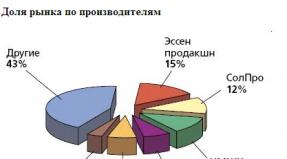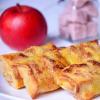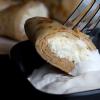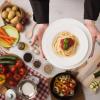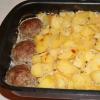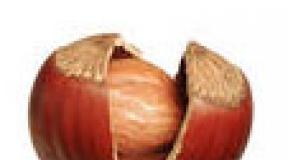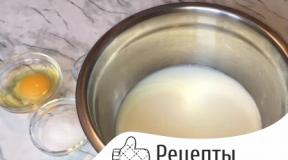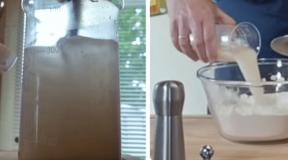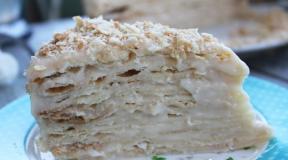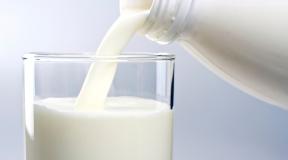Easter cake - a simple recipe with a photo step by step and a video for beginners and experienced chefs: without yeast and dough, with dry yeast - A selection of delicious recipes for Easter cakes in the oven and multicooker. Easter cake according to the classic recipe, like grandma's
0 266526
Photo gallery: Easter cake - a simple recipe for beginners without yeast and dough
It is quite difficult for inexperienced hostesses and novice confectioners to work with yeast, to properly prepare dough for cakes. The main problem is the correct mixing of dry yeast with milk or water, a long wait for the dough to rise. But using simple and detailed recipes, it will not be difficult to cook fluffy and tender cakes. The proposed photo instructions and video master classes will help you prepare good pastries for Easter. When baking a cake with a simple recipe, which is indicated in the article, you do not have to worry about its density or insufficient softness: even without yeast or in a multicooker, you can make delicious pastries.
Delicious Easter cake for beginners - a simple recipe with step by step photos

Even inexperienced housewives can cook a delicious cake without any problems if they use a simple and understandable recipe. Although it includes the preparation of dough, it does not require special skills. A simple cake recipe is suitable for beginners and for joint preparation for the Easter holiday with children. The main thing is to follow the specified instructions and monitor the correct use of the ingredients. And it will help to prepare a simple Easter cake step by step recipe with the photo below.
Ingredients for a Delicious Newbie Cake
- flour - 2 kg;
- milk - 1 l;
- sugar - 4 tbsp.;
- live yeast - 90 g (you can replace 30 g dry)
- egg yolks - 10 pcs.;
- drain. oil - 100 g;
- rast. oil - 50 ml;
- raisin.
A simple photo recipe for a delicious Easter cake for beginners

How to cook a simple cake without yeast and without dough - photo recipe with instructions

You can make a delicious and tender Easter cake without using yeast. For a delicate dough texture, use a baking powder. A simple recipe without dough, indicated below, will help to cook Easter cake. The main ingredient in it is not milk, but kefir. This ingredient will also help to prepare original sweet pastries. In addition, you can use a simple recipe without yeast to make Easter cake for vegetarians: the dough does not include chicken eggs.
List of ingredients for making a simple cake without yeast and without dough
- flour - 3 tbsp.;
- kefir - 500 ml;
- baking powder - 1 tsp;
- rast. oil - 1 tbsp.;
- sugar - 1.5 tbsp.;
- raisin.
Photo recipe with instructions for making cake without yeast and without dough

A simple recipe for Easter cake on dry yeast - with photo instructions for cooking

Using dry yeast makes it pretty easy to make any baked goods. At the same time, Easter cakes are both fluffy and soft. A simple recipe on dry yeast, proposed below, will help hostesses bake Easter cake.
Ingredients for making simple Easter cake with dry yeast
- flour - 1 kg;
- milk 400 ml;
- sour cream - 250 ml;
- dry yeast - 11 g;
- drain. oil - 200 g;
- sugar - 200 g;
- eggs - 5 pcs.;
- raisins, candied fruits, walnuts.
A simple photo recipe with instructions for making Easter cake with dry yeast

An original and simple Easter cake in a slow cooker - a recipe with step-by-step video instructions

Cooking any pastry using modern technology allows you to forget about the problems with burnt pastries, their unbaked center. It is very convenient to bake holiday cakes in a slow cooker. Thanks to the uniform heating of the dough, it rises well and bakes correctly at the same time. The hostess will only have to choose the appropriate cooking mode.
A step-by-step video recipe for an original and simple Easter cake in a slow cooker
Making Easter baked goods with modern technology is as easy as shelling pears. The recipe discussed below will help make a delicious simple Easter cake:
Detailed simple recipes for making Easter cakes with photo instructions

You can cook your favorite Easter baked goods not only in the usual paper or metal forms. It can be easily shaped into a braided roll. And simple recipes for Easter cakes indicated in this article will help all novice confectioners in this. One of these helpful instructions can be found below.
Ingredients for a simple Easter cake recipe
- milk - 1 tbsp.;
- flour - 6 tbsp.;
- sugar - 1 tbsp.;
- dry yeast - 1 tsp;
- drain. oil - 0.5 tbsp.;
- vanillin, cardamom - 0.5 tsp each;
- zest of 1 orange.
Detailed photo instructions for the recipe for making a simple Easter cake

Even a beginner can correctly conduct the preparation of a delicious and tender Easter cake. You just need to choose the best recipe and carefully read the list of ingredients, the rules for mixing them. The simple recipe indicated above will help you easily and quickly prepare an Easter cake. This can be a photo instruction describing baking pastries for Easter with dry yeast. Or you can choose a recipe without yeast and without dough. A step-by-step video instruction will help to simplify the preparation of Easter cake and make it in a multicooker without any problems. Each of the considered master classes is suitable for inexperienced hostesses who want to learn how to cook original and soft Easter cakes.
Easter cake is a traditional festive dish on the Christian holiday of Easter. Today there are a lot of interesting recipes that allow you to create an exquisite and unique treat for a festive table - a classic recipe for baking on dough, you can also cook different baking options - with nuts, candied fruits, chocolate and other additions. Our Easter cake recipes will decorate your holiday table.
In this article, you will learn:
Easter cake: recipes
Easter cake recipesEaster cake is a traditional treat that is on the table of every person on the Christian holiday of Easter. The classic recipe involves baking with dough. The cake is decorated with protein cream with sprinkles, candied fruits or almond flakes.
Today there are a lot of interesting recipes that allow you to create an exquisite and unique treat for the festive table.
There are many delicious recipes for cakes due to the specifics of dough preparation, baking method or additional ingredients - raisins, candied fruits, nuts, dried fruits. They all differ in their composition and preparation method. A variety of variations allows novice housewives to experiment freely. This is the best way to surprise families and find their own special recipe.
Easter cake classic recipe

The classic recipe is the simplest. It is based on the following ingredients:
- 1.2 kg;
- 125 ml of milk;
- yeast packaging;
- 15 yolks;
- 250 g sugar;
- salt to taste;
- oil packaging.
Cooking a classic Easter:
Yeast Easter cake with candied fruit and raisins

Kulich with candied fruit and raisins is a delicious treat that will please both adults and children. Standard components:
- 1 kg of flour;
- dry yeast packaging;
- a glass of warm milk;
- oil packaging;
- 5 eggs;
- 125 g sugar;
- 300 g of candied fruits;
- vanilla powder;
- h. l. salt.
Cooking Easter cake with yeast:
- Easter cake must be prepared on a sponge basis.
- It involves mixing yeast with warm milk and half a given amount of flour.
- While the dough is coming up, the main dough is being prepared.
- To do this, flour, eggs, sugar and dried fruits are mixed together.
- You need to knead them well, then the resulting dough is allowed to rise 2-3 times.
- Then it is mixed with dough and sent to the oven, preheated to 200 degrees, for about 30-40 minutes.
- After readiness, a protein glaze is used, which is applied to the top of the cake and decorated with powder.
Easter "Tsar" recipe
Tsar's cake is an exquisite delicacy that is notable for its quick preparation. You need to prepare the following ingredients:
- 500 g cream;
- 50 g dry yeast;
- 1 kg of flour;
- oil packaging;
- 10 grains of cardamom;
- 15 yolks;
- candied fruits, almonds, nuts - 300 g.
Cooking Royal Passover:
- You need to cook step by step. First of all, 250 ml of cream is heated over low heat.
- In the meantime, about 2.5 cups of flour are measured out.
- When the cream is done, yeast is added to it.
- Dough is placed from the resulting mixture.
- While it is rising, you can start preparing another part of the dough.
- To do this, all the remaining ingredients are mixed into one mass.
- When the dough is suitable, it is added to the resulting consistency.
- Everything is mixed thoroughly and sent for 2-3 approaches to a warm place.
- The treat is prepared in a bread maker or oven, the temperature should be no more than 160 degrees.
Old batter Easter recipe

An old batter recipe is an extraordinary baked product with excellent taste. Necessary:
- 8 glasses of flour;
- 2 packs of yeast;
- liter of milk;
- 20 yolks;
- vanilla;
- melted butter (200 ml);
- sugar and salt to taste.
Preparation:
- Easter is prepared with standard dough. To do this, you need to warm up the milk and dissolve the yeast in it.
- Then the flour is sifted and exactly half of it is added to the dissolved yeast. This is the dough, which is removed to a warm place. While it rises, the butter is melted over low heat, and the yolks are ground with sugar.
- The finished dough is mixed with all the components to a homogeneous consistency.
- Then the dough is laid out in forms and baked at a temperature of 160 degrees, no more than 50 minutes.
A standard treat can be plain or with raisins.
A quick recipe for Easter without dough

If there is no time to prepare a classic recipe, you need to pay attention to the cake without dough. The following ingredients are required:
- a glass of milk;
- Art. l. yeast;
- 4 eggs;
- a glass of sugar;
- 100 g butter;
- vanillin;
- 4 cups flour;
- dried fruit to taste.
Cooking Easter without dough:
- This is a simple recipe without kneading, all the ingredients are mixed together and sent to a warm place before the first approach. The main thing is not to forget to melt the butter.
- After the approach, the dough is distributed in tins and baked in the oven for 45 minutes at a temperature of 160-170 degrees.
Yeast-Free Easter Recipe

Small child treats should be yeast-free. This recipe requires the following ingredients:
- 200 g of cottage cheese;
- 2 eggs;
- a quarter glass of sugar;
- one and a half glasses of flour;
- quarter teaspoon soda;
- half a spoonful of lemon juice;
- candied fruit;
- raisin.
Cooking Easter without yeast:
Yeast-free Easter is tasty and fast:
- All ingredients are mixed with each other (soda is pre-extinguished with lemon juice).
- After thorough kneading, the dough is poisoned into the multicooker for the "Baking" mode.
- The cake will be ready within 40-50 minutes.
- Cooking in a multicooker is quick and comfortable. After readiness, the treat is cooled and decorated with protein.
Easter cake with orange peel

Easter cake with orange peel will help to surprise the household. You need to prepare:
- 5 glasses of flour;
- 250 ml of milk;
- dry yeast packaging;
- a glass of sugar;
- 200 g butter;
- 5 yolks;
- 2 eggs;
- a tablespoon of orange peel;
- half a glass of raisins.
Step-by-step preparation of a festive cake:
- Dough is prepared from milk and yeast and 2.5 glasses of flour.
- In the meantime, the butter is melted, yolks, ground with sugar, and orange peel are added to it.
- When the dough comes up, all the remaining ingredients are sent into it. Raisins are added at the end.
- The resulting dough is sent to a warm place for 2-3 approaches.
- If you don't want to use an orange, lemon cake is the best alternative.
- Everything is prepared in the same way, baking is baked in the oven for 40-45 minutes.
Butter Easter cake according to Italian technology

If you want to cook Easter cake, the most delicious recipe is based on the use of Italian technology. For dough you will need:
- half a glass of flour;
- a glass of warm milk;
- dry yeast - 25 g.
For the test you need:
- half a glass of sugar;
- oil packaging floor;
- 2 eggs;
- one yolk;
- 2 cups of flour;
- dried fruit to taste.
Cooking butter cake:
- Butter yeast dough starts with dough. To prepare it, 3 main ingredients are mixed, the resulting mass is sent to a warm place.
- Until it reaches a certain condition, you need to do the test itself. It is based on the second list of ingredients. There is nothing special in mixing them, all components are mixed with each other and added to the dough.
- The resulting dough is suitable 2-3 times in a warm place. Then it is distributed in tins and baked.
Easter cake in a slow cooker recipe

Easter cake in a multicooker is quick and easy. You need to prepare the following components:
- 2 cups of flour;
- glass of water;
- oil packaging floor;
- a glass of sugar;
- 3 eggs;
- dry yeast packaging;
- a bag of vanilla sugar;
- nuts and candied fruits to taste.
Cooking Easter in a multicooker:
- To begin with, a dough is prepared by dissolving the yeast in warm milk.
- A glass of flour is added to the resulting mixture and all this is sent to a warm place.
- While the dough is coming up, the second part of the dough is being prepared.
- To do this, you need to mix all the ingredients.
- Then they are added to the dough, thoroughly mixed until a homogeneous consistency.
- The resulting mass is cooked using a multicooker, using the "Baking" program.
Easter cake for Easter

Monastic cake is a familiar type of delicacy, which is distinguished by its simple preparation. The following components must be prepared:
- 4 cups flour;
- 300 ml of milk;
- 4 egg yolks;
- 150 g margarine;
- 2 tbsp. l. Sahara;
- 100 g of nuts and dried fruits;
- 80 grams of fresh yeast;
- half a package of butter.
Cooking monastery cake:
Easter recipe for kefir

You can cook a treat with kefir and margarine. For this, the following components are selected:
- 8 glasses of flour;
- 2 glasses of sugar;
- half a kilo of margarine;
- 100 g yeast;
- liter of kefir;
- 125 ml melted butter;
- 8 eggs;
- vanilla sugar;
- 300 g of dried fruits.
Cooking Easter with kefir:
Easter cake recipe with dried fruits

Photo recipes help you prepare a delicious treat without much effort. To create a real masterpiece, you need to take the following ingredients:
- 1 liter of kefir;
- 8 glasses of flour;
- 100 g yeast;
- 2 packs of butter;
- 7 eggs;
- 3 cups of sugar;
- 125 ml of vegetable oil;
- 200 ml of brandy;
- vanilla sugar;
- 300 g of dried fruits.
Preparation:
First, the dough is prepared. To do this, a liter of kefir is heated in a microwave oven and mixed with yeast. Add 4 cups of flour to the resulting mass, beat it all with a mixer and send it to a warm place. While the dough is rising, it is necessary to make the main workpiece. For this, all the presented ingredients are mixed (except for cognac and dried fruits). The resulting mixture is supplemented with dough until a homogeneous mass is obtained. Dried fruits and cognac will help improve the taste. Cook at 200 degrees for about an hour.
Special Easter with candied fruits and almonds

The right dough for Easter cake - the recipe has a special one. It should always be based on dry yeast, they allow you to make the baking airy and light. For cooking, you need the following components:
- 2 glasses of milk;
- 6 eggs;
- 250 g sugar;
- yeast packaging (50 g);
- a bag of vanillin;
- 1 kg of flour;
- 200 g of candied fruits;
- 200 g of almonds.
Recipe:
- Dough is prepared according to the classical method, by mixing yeast with a glass of flour and milk. The mixture is sent to a warm place.
- Meanwhile, the hostess is preparing the main part of the dough. To do this, simply mix all the ingredients, it is recommended to use a mixer. This will add airiness to the dough, then dough is added to it.
- Everything is mixed again and sent to the oven for an hour.
Italian Easter Panettone Recipes
Panettone is a traditional Easter cake from Italy, which is very popular in other countries due to its exquisite taste. Made according to a special recipe, Italian Easter is distinguished by its very soft dough, which is easier to tear than to cut, it melts in your mouth and gives a lot of pleasure. Panettone also has a variety of recipes - with raisins, candied fruits, chocolate and nuts, additives can be used based on personal taste preferences.
 Photo: Italian Easter Panettone
Photo: Italian Easter Panettone Tsureki Greek Easter Recipes
Tsureki is a kind of Easter in Greece, unique for its decoration with eggs. Such a cake is convenient because it is the main decoration of the festive table for Easter, as well as a kind of stand for eggs.
 Photo: Greek Easter Tzureki
Photo: Greek Easter Tzureki Easter cottage cheese - a variety of recipes
Easter cottage cheese is one of the varieties of Easter cake for the holiday, which consists mainly of cottage cheese. Such Easter can be different with respect to the method of its preparation - raw, custard, or boiled in the oven or microwave, as well as with respect to additional ingredients - with izum, candied fruits and dried fruits. Chocolate or Tsar's cottage cheese, multi-layered and mostly sweet - an excellent decoration on the table on a Christian holiday, which were prepared by Russian cooks from the past centuries.
 Easter cottage cheese recipes
Easter cottage cheese recipes Video: a step-by-step recipe for Easter cake
Video: how to cook Easter cakes
Christ is Risen and bon appetit!
This time I baked, or rather, without long kneading with my hands. All you need to do to prepare the dough for such cakes is to combine the ingredients and mix them thoroughly with a spoon. And for the preparation of such "fast" cakes, of course, it also takes time, but this is the time required for the rich yeast dough to come up, that is, you can do other things at this time. I baked cakes without kneading for the first time, I can say that they fit perfectly, they turned out to be very beautiful and fragrant. And delicious :) The recipe, I think, will come in handy for those who will bake Easter cakes on their own next year. As promised, I'm adding step-by-step photos.
Ingredients:
For the test:
- 500 ml milk
- 6 eggs
- 200 gr. butter(or margarine)
- 2.5-3 tbsp. Sahara
- 1 stack raisins (140 gr.)
- 2/3 stack (85-100 gr.)
- 50 gr. live yeast or 16 gr. dry
- ½ tsp salt
- 3-4 table. l. vegetable oil(sunflower) + for lubricating molds and hands
- 1200-1500 gr. flour (it took me 1235 grams of flour)
- 1.5-2 tbsp. l. rum or cognac
- 24 gr. vanilla sugar
- 2 cloves star anise - optional (alternatively, use other aromatic spices such as nutmeg)
- 1/4 tea l. turmeric - optional
For glaze:
- 2 squirrels
- 2 tea tablespoons of lemon juice
- 2 / 3-1 cup caster sugar
Preparation:
- We measure and prepare the products. Wash and sort the raisins, pour hot water for 15 minutes, then drain and leave the raisins to dry on a sieve or on a clean towel. I prepared raisins, candied fruits and forms in the evening.
- Candied fruits (if necessary, first cut them into medium-sized cubes) fill with rum or cognac, mix well, cover the dishes with a lid and leave for at least 30 minutes (I left them until morning).

- We prepare forms for baking cakes: wash, dry, grease the bottom and sides with sunflower oil, sprinkle them with flour. Or we line the bottom and sides of the forms with baking paper (the paper can also be additionally greased with vegetable oil).
- We heat the milk until warm, pour out ½ cup for the dough.
- Preparing dough for Easter cakes without kneading. Stir 1 table in ½ cup of warm milk. l. sugar, yeast and 1 table. l. flour.

- We put to come up in a warm place for 15-20 minutes.

- Put butter (or margarine) in the remaining warm milk, heat until the butter melts, put it out in the cold to cool until warm.

- Grind star anise (or nutmeg) into powder. I combined star anise, vanilla sugar and turmeric and ground it all together in a coffee grinder.
- Mix eggs with sugar and vanilla sugar and spice powder.

- Beat the eggs with a mixer or whisk.

- Add to the beaten eggs milk and butter, cooled to warm, mix.

- Add the suitable dough, salt, vegetable oil to the egg-milk mixture, mix.

- Pour in raisins and candied fruits with rum, mix.

- Add the sifted flour in parts. After adding 1 kg. flour, add the remaining flour 1-2 tbsp. spoons.

- Stir with an ordinary spoon and check - when the spoon in the text does not fall, but remains standing (it can tilt slightly) - there is enough flour. Stir the dough with a spoon until there are no traces of unmixed flour in it.

- Ready-made dough for cakes without kneading does not reach for a spoon, but comes off.

- Leave the cake dough warm for 2-6 hours, until the dough increases 2-3 times. My dough in a warm (30 degrees) oven came quickly, in 2 hours.

- Then knead the dough with a spoon. We collect a little vegetable oil in a bowl, moisten our hands in it, collect the dough and fill the prepared forms for cakes to 1/3 of the volume.

- Leave the dough in the molds to come up in a warm place until the dough grows almost to the edges of the molds. This can take 1 to 3 hours. The second time the dough came up for me for a rather long time - 2-3 hours.

- When they come up, grease the surface of the cakes with a brush or feather with vegetable oil and bake in a hot oven (170-180 degrees). As with baking others, the tins in the oven should not touch each other. After 15 minutes, we check if the top of the cakes is already brown enough, you can cover them on top with foil so that they do not burn. We do this quickly so that the dough does not settle. In total, we bake cakes for 40-45 minutes, large ones - up to 60 minutes. We check the readiness with a sharpened stick or a wooden skewer.
- Let the ready-made cakes cool in the forms, take out.

- Do not leave the cakes in the molds for a long time, so that the bottom does not get wet. If the cakes are large, you can take them out of the molds and cool them by laying them out on pillows covered with towels, periodically turning them so that they do not deform under their own weight.

- Cooking. Beat the egg whites with a whisk or fork with a little sifted icing sugar and lemon juice.



- Add the icing sugar until you get the desired icing thickness. It should be pretty thick.

- How to cook painted Easter cakes. We put 1 table in a separate cup. l. protein glaze, tint it with beet juice or other paint to the desired color (just a few drops are enough), thicken the glaze, adding a little more powdered sugar. This is necessary so that the glaze is not liquid, and not glass from the cake together with patterns. We cover the cake with white glaze, if you like, you can apply a little more glaze in some places around the edge so that it flows nicely. If the glaze runs off too quickly, then you still need to thicken it with powdered sugar.

- We apply patterns on the cake. Apply dots of colored glaze with a match to the white glaze, stretch them with the sharp end of a toothpick or a match, drawing a pattern. First, you can practice on a platter.
- Painted Easter cake can be additionally decorated with multi-colored and shiny sprinkles, mastic or candied fruit decorations. We leave the cake to dry. This is how we decorate all the cakes. Happy Easter to you!

- This is how the cakes look without kneading in the context.

Bon Appetit!
Step-by-step recipes for Easter cake on dry yeast and milk, with eggs, sour cream and kefir
2018-04-03 Marina VykhodtsevaGrade
recipe
Time
(min)
Servings
(people)
In 100 grams of ready-made dish
6 gr.
10 gr.
Carbohydrates
48 gr.310 kcal.
Option 1: Classic Easter cake with dry yeast
Previously, raw pressed yeast was always used for Easter cakes. But gradually this ingredient was replaced by a dry analogue. Raw yeast is now not available everywhere. They require certain conditions for storage, can die or become moldy, and have different lifting power. With dry yeast, everything is much easier, they can just lie in the closet and wait in the wings. In addition, most are marked "fast-acting" and it really is, they are stronger, you need less dry yeast.
Ingredients
- 12 g dry yeast;
- 800 g flour;
- 450 ml of milk;
- 4 yolks;
- 180 g sugar;
- 160 g butter;
- 5 g salt;
- 85 g raisins;
- 2 g vanillin.
A step-by-step recipe for a classic cake
Traditional kulich is prepared using yeast dough with dough. It is with her that you need to start. We start with warm milk, its temperature should be slightly higher than that of the body. Be sure to add 2-3 tablespoons of sugar, take from the total amount, introduce yeast, and then add flour. The dough should be thinner than the dough, due to its consistency, it will rise quickly and easily. Leave it warm for 2.5 hours.
Rinse and dry the raisins, just put them on a napkin. The butter must be melted and set aside to cool. We mix sugar with yolks, salt, proteins are not used in the dough, they are usually left for fondant. Pour all this into the dough, mix, and then add the flour with vanilla and raisins.
We crumple the dough thoroughly, then remove it. The mass is sweet and heavy, so it will take a long time to come up. You need to wait for one high-quality rise, an increase in volume three times.
Next, the dough must be divided into cakes. We put a rounded piece in each shape, it should take half the rise. We leave to come. In time it will take at least another hour. The dough should "pop" out of the cup.
Disbanded Easter cakes are placed only in a preheated oven. In the first minutes they will still rise, a "hat" will appear. We bake at 180 degrees so that the cakes are baked inside. Then cool, cover with fondant and sprinkle with colored dragees.
Cooking Easter cakes will take almost a whole day, it is important to prepare everything you need and work in a warm room without drafts. Yeast dough does not like coolness. For the same reason, it is advisable to heat all products.
Option 2: Quick recipe for dry yeast cake without eggs
There are options for faster dry yeast cakes. Such a dough does not require very much attention, you do not need to start a dough, but it will still have to stand in the heat for several hours. Another recipe for milk.
Ingredients
- 300 ml of milk;
- 100 ml of water;
- 150 g sugar;
- 120 g butter;
- 11 g yeast;
- 50 ml of vegetable oil;
- flour;
- 80 g raisins.
How to quickly cook
Although the dough is without dough, the yeast needs to be given a little time to activate, this will significantly save time on the rise. Mix with warm water, a couple of tablespoons of sugar and flour. You will get a slightly whitened chatterbox, let it stand for a quarter of an hour.
There is time to wash the raisins, melt and cool the butter, just heat the milk. We add all this to the dough, be sure to salt, add flour after dissolving, make an ordinary soft dough, adding vegetable oil. No need to knead cool. The mass clogged with flour will not rise well, and the cakes themselves will crumble when sliced.
We put it away in the warmth. Since the dough was not done, the dough will need to rise twice. The first time it will take longer, then the process will go faster. After the second time, put the dough into cups.
As soon as the mass in the tins (cups) rises from half to the top, you can bake the cakes in the oven. Temperature 180-190, cooking time will vary by size.
If suddenly the dough stands for a very long time and rises slowly, then you can put it over hot water, just heat it up in a saucepan, periodically turn on the stove under it. It is only important not to boil, high heat will also damage the yeast dough.
Option 3: Kulich on dry yeast with candied fruits
A very fragrant version of Easter cake. In addition to candied fruits, a little raisins are also added to it. The dough can be made not only with milk, but also with its mixture with water.
Ingredients
- 0.7 kg flour;
- 110 g candied fruits;
- 150 g butter;
- a pinch of cardamom;
- 1 tsp grated zest (optional);
- 180 g sugar;
- 5 yolks;
- 0.5 liters of milk;
- a little vanilla;
- 70 g raisins;
- yeast bag (11 g).
How to cook
We introduce yeast into the warmed milk, wait for the grains to dissolve. While we separately mix the sugar with the yolks, grind thoroughly, add the melted butter, pour into the milk mixture, salt the dough, just a little more than half a teaspoon is enough.
We begin to knead. Pour in mute flour, about a glass, vanilla, cardamom and zest on top. Stir with the bulk. Then add the washed raisins and candied fruits, add more wheat flour until a homogeneous, non-flowing dough is obtained.
Leave the cake dough to rise for about four hours. Then we form balls, put them in cups, bake after lifting.
When forming cakes, it is desirable that candied fruits and raisins do not peep out. If the pieces stick out, it is better to immediately remove them from the top of the head, otherwise they will still burn.
Option 4: Easter cake with dry yeast and sour cream
A variant of the dough for cakes with sour cream and dry yeast. It turns out very soft, delicate pastries with a creamy taste. You can cook it with both raisins and candied fruits, therefore, simply dried fruits are indicated below. We select to your taste.
Ingredients
- 14 g yeast;
- 200 g sour cream;
- 300 ml of milk;
- 3 yolks;
- flour;
- 200 g sugar;
- 200 g of dried fruits;
- 100 g butter;
- vanilla.
Step by step recipe
We make a weak dough in milk. To do this, we heat the liquid, add yeast and a little sugar, one cake is enough. Then add dry yeast, stir, add flour. We remove for an hour.
We mix sour cream and yolks, add sugar and a little salt, an incomplete teaspoon is enough. Beat everything thoroughly, pour in the melted butter.
We send the sweet mixture to the dough. After bringing to homogeneity, add dried fruits (candied fruits), additional flour. Pour in and knead until the dough is soft, smooth, it should not spread.
Next, we go the classic way: we leave the dough to rise, it is better to let it do it twice. Then we divide it into pieces and put it in the molds, let it rise again. We bake holiday cakes until tender. We use any fondant for decoration.
In addition to raisins, dried apricots can be added to the cake dough, only first cut into small cubes, like candied fruits.
Option 5: Kulich on dry yeast and kefir "Peerless"
For such a cake you will need kefir. It is advisable to take a not very acidic product with a high fat content. In general, this recipe has a rather modest composition of products, but this only has a positive effect on the result. The dough is light enough, rises well and quickly, especially in a warm room.
Ingredients
- 700 ml of kefir;
- 11 g yeast;
- 3 eggs;
- 60 g butter;
- 100 g sugar;
- vanilla and salt;
- 700 g flour;
- 80 g raisins;
- 30 ml of vegetable oil.
How to cook
Mix vanillin with flour immediately, you can add other spices to them, for example zest, cinnamon. We heat kefir, mix with yeast and granulated sugar. Introduce the separated yolks and beat all the ingredients thoroughly until dissolved.
We melt the butter, measure out the vegetable oil, pour it all into the dough, add the flour and knead. Do not forget to add raisins, which can be replaced with candied fruits. We put it in a warm place for at least two hours. Then we lower the mass, wait another 30 minutes. After that, you can lay out the dough into shapes.
We put in a warm place for 20 minutes, the kefir dough is no longer needed. As soon as the cakes rise a little, we send them to the oven, in it they will become even higher. We bake cups for 150-200 half an hour, temperature 200. Then grease, decorate to your liking.
You can also knead the dough with proteins, but they make the baked goods tougher. Sometimes they use several whole eggs and some yolks for holiday cakes.
a few more recipes for Easter.
The first and the last are tried
KULICH ON OPAR
For 1 kg of flour -
1.5 cups of milk
5 eggs,
300 g butter or margarine,
1.5 cups sugar
40-50 g yeast,
3/4 spoon of salt
150 g raisins
50 g candied fruits,
breadcrumbs,
vanillin, cardamom to taste.For lubrication Easter cakes before baking: 1 yolk.
For glaze: 1 protein, 1/4 cup sugar.
Dissolve the yeast in warm milk, add half the flour. Stir well to avoid lumps. Cover with a towel and place in a warm place.
When the volume doubles, add 5 yolks, ground first with salt (note that the yolks will darken at the same time), then with vanilla, cardamom and granulated sugar, adding a little of it. After the crushed yolks, put melted (but not hot) butter or margarine in the dough. Knead very thoroughly, then add 5 whites whipped into a thick foam and the remaining flour.
Continue to knead until the dough begins to freeze from your hands and utensils. The quality of the cakes largely depends on how well the dough is kneaded. Put the kneaded dough in a warm place and when it doubles again, add the washed and dried raisins, candied fruit diced, vanillin, cardamom.
Divide the dough into molds (aluminum pots can be used). Pre-grease them with oil and sprinkle with breadcrumbs, and cover the bottom with oiled paper, cutting out to the size of the mold. It is more convenient to cut the dough if the hands are oiled. Fill the forms one third with the dough and place them in a warm place, covered with a towel.
When the dough rises and takes 3/4 of the shape, brush the top of the cake with yolk. Place the cakes in a not very hot oven for 50-60 minutes. In the oven, turn the tins from time to time, but do so carefully, otherwise the dough may sink. To prevent the top of the cakes from burning, cover them, after they are browned, with a circle of paper moistened with water.
Determine the readiness of the cake with a thin splinter. Stick it into the cake and take it out. If dry, then the cake is ready. If soggy, the dough is not baked yet.
When they have cooled down, cover the finished cakes with white icing and garnish with candied fruit pieces. Make the frosting with 1 protein. It must be whipped into a thick foam and added gradually, continuing to beat, 1/4 cup granulated sugar.
KULICH WITHOUT OPARA
The products are the same as in the previous recipe.
Dissolve yeast in warm milk, add 4 cups flour. Add salt, yolks crushed with sugar, melted but not hot butter or margarine, whites whipped into a thick foam. Stir well and, covering the dough with a towel, put in a warm place overnight. In the morning, add the rest of the flour, vanillin, cardamom. Knead thoroughly and put back in a warm place to rise. When the volume of the dough has doubled, add raisins, candied fruits. Stir the dough and place in oiled tins. Then proceed in the same way as described in the previous recipe.
KULICH ECONOMY
For 1 kg of flour -
3 eggs,
250 g sugar
100 g margarine or ghee,
3 tbsp. tablespoons of vegetable oil
about 1/2 liter of milk
1 tbsp. a spoonful of rum,
vanilla,
50 g yeast
1 teaspoon of salt.
Dissolve yeast in a little milk. Then take 3-4 tbsp. tablespoons of flour and pour boiling milk over it. Stir well so that there are no lumps left. Let cool until warm and mix with yeast. Beat the dough until bubbles appear. Sprinkle flour on top, cover with a towel and place in a warm place.
When the dough comes up, put it in a sauerkraut with flour, add yolks, ground with sugar and vanilla, and salt. Pour in the remaining milk. Stir. Beat the whites into a thick foam and place them in the dough too.
Knead it for at least half an hour, collecting from the edges to the middle. Pour in vegetable oil, rum, melted margarine in small portions. If the dough is too tough (it depends on the size of the eggs), add a little more warm milk.
Place in a warm place. After 2-3 hours, when the dough is good enough, you can lay it out in molds, as in the recipe for "Kulich on dough".
QUICK COOK
For 4 glasses of flour -
3 eggs,
100g butter or margarine,
1 cup of sugar,
1 glass of milk
50 g yeast
salt to taste.
Dissolve the yeast in warm milk, mix thoroughly with eggs, melted butter or margarine, sugar, salt and flour. Put this dough immediately in oiled tins and put in a warm place for 3-4 hours, after which you can bake.
ORDINARY EASTER
For 800 g of cottage cheese -
1 tbsp. a spoonful of butter
1 tbsp. a spoonful of sour cream
5 yolks,
5 tbsp. tablespoons of sugar
300 g cream (milk can be used),
vanillin,
salt to taste.
My comments are in italics.
Rub the cottage cheese through a colander (sieve, meat grinder, mixer, harvester) together with butter and sour cream (curd should not be wet)... Add salt.
Put all the yolks and sugar in another dish (you can add more sugar to taste), cream and vanillin (it is better to beat everything: first, only the yolks, gradually add sugar, and then everything else)... Put on a small fire (you can use a water bath), stir continuously until the mixture thickens. Do not bring to a boil.
Pour the hot mass into the cooked curd, stir thoroughly. Hold it a little more over low heat and put in a napkin or gauze bag. Place this bag for 6 hours in a special shape (colander) under oppression.
Use the delicious liquid leaked from Easter to make pancakes, pancakes, pudding, casseroles.
Carefully transfer the finished Easter to the ceremonial dish (with sides)... Decorate from above, as fantasy tells (can be poured with melted chocolate).
From the book Korotun L.G. " Breakfast? Dinner? Dinner? - No problem!"


